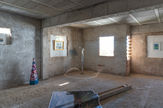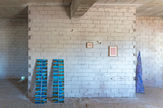
Villa Babel
Arantxa Boyero, Marijo Ribas, Florence de l’Olivier, Sergio Monje, Elisa Braem, Biel Llinàs.
Exhibition curated by Aina Pomar Cloquell
In its edition of 16 August 1958, Quincenal de intereses locales Santanyí (the town’s local fortnightly magazine) presented Cala Figuera as “more or less like a new Babel. Young and old, blonde and brunette people. A diversity of languages and opinions”. In the 1950s, the Cala was an unusual place, still not very urbanised, which provided peace and quiet for those who sought it and fun for the first tourists and holidaymakers in the area.
Some of the first fincas and hostels adopted the prefix “Villa”, a non-native term but which, probably due to Italian influence, had already been used for years on the island to give a differentiated name to both year-round and holiday homes.
The terms Villa, as an architectural entity, and Babel, to refer to the coexistence of aspects of different origins, point to the exhibition’s key concept: habitar.
The word “habitar” (to inhabit or to dwell) activates the research process of this project, and can be progressively fragmented into three blocks, permeable and intertwined with each other. The exhibition approach integrates not only the artists material works, but also the collective capacity to generate situations in the form of encounters, conversations, readings and reflections fostered by these blocks. The works, objects and documents that are part of the exhibition can be read as springboards towards these situations.
But what are the blocks of this dwelling to which we refer here? Time and the impossibility of inhabiting it is the most ethereal component that runs through
the whole project. Quotations from Barthes and Arnaud connect with the idea posterity, and the past is invoked through references to Cala Figuera’s past. The present, intangible and elusive, is at the core of the works of Elisa Braem and Florence de l’Olivier.
The second element, possibly because it is more palpable, is more widely represented in the project: space. To inhabit a space can refer to occupying a specific place, perhaps a room of one’s own, perhaps a shared place. Heidegger reminds us that only if we are capable of dwelling, only then can we build. The idea of space navigates, through the works of Biel Llinàs, Marijo Ribas, Arantxa Boyero and Sergio Monje, between the natural and the artificial, passing through the real and the constructed landscape, negotiating between the immediacy of the latter and its representations.
Throughout the preparation of this project, the artists and the curator wanted to place themselves in the surroundings of Babel, on the Santanyi coast and in Cala Figuera, paying special attention to their places of encounter. They have asked themselves: how are these specific spaces inhabited? With this premise, on 20 April 2024, they gathered in the exhibition space to inhabit it.
This encounter, developed through walks, conversations, exchanges and, essentially, a common physical presence, points towards the third component of dwelling, inherent to all the others: inhabiting a body. During the hours of the meeting, Villa Babel was created, a receptacle of objects, works, documents and conversations around the question of dwelling, integrating the immediate environment as a catalyst for these reflections.
Aina Pomar Cloquell
Curator
Biel Llinàs
https://bielllinas.hotglue.me/
Arantxa Boyero
https://www.arantxaboyero.com/
Marijo Ribas
Elisa Braem
https://www.galeriafermay.com/artists/16/elisa-braem
Sergio Monje
https://www.instagram.com/sergio_monje_/
Florence de l’Olivier














